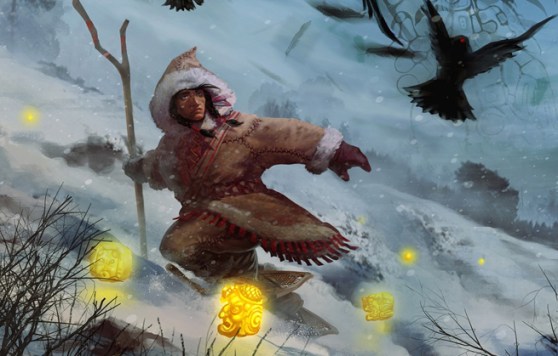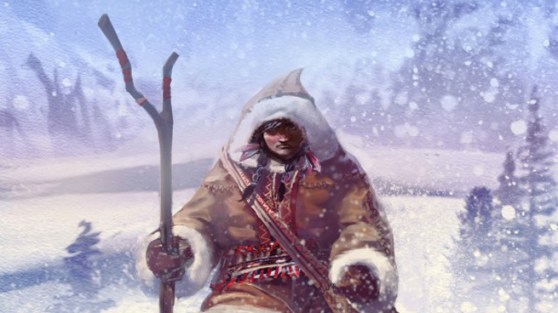Vander Caballero doesn’t know how his new game ends. He’s not even entirely sure what it’s going to do yet. But he does know what he wants it to say.
“Bullying is a problem that cannot be solved by fighting, by getting stronger, by punching back,” he says. “It doesn’t get solved like that. You can’t resolve everything by fighting. Overcoming bullying is something that has to be done without power-ups.”
Where Caballero’s 2012 puzzle-platformer Papo & Yo presented an emotionally jarring allegory on abusive father-son relationships, his new project, Silent Enemy (planned for release before year’s end, possibly for Ouya), uses mythic elements to explore the very real, very modern issue of bullying.
Silent Enemy takes place in a permanent winter ruled by malevolent crows who keep the spring at bay. “In the spring, there’s a lot of food around, and they become normal birds,” says Caballero. “But in winter, they’re in power because people are starving.” A young Inuit called Boy steps up to explore the snow-covered forests and find the glowing spirit shards that can change the endless winter and restore the natural order. Once found, those little glowing spirits follow Boy around and play directly into the game’s puzzles by taking on different attributes.
Caballero demonstrates by stretching the yellow spirit-string across a river to touch a small shrine. The yellow Spirits of Melting turn into blue Spirits of Freezing. Now Boy can flash-freeze chunks of the river rapids. Instant bridge. The Spirits of Possession switches control to nearby animals who can reach areas Boy can’t. I watched a convenient bunny go down a literal rabbit hole to secure another spirit ball for Boy’s collection. Players control Boy’s string of spring-spirits using touch controls — in Ouya’s case, the pad on the controller. Demoing the game on an iPad, Caballero also guided Boy with basic touch tracking. On a console, the analog stick takes over that duty.
What does this have to do with bullying? Not much. Yet. But just like any bully, those crows like getting power, maintaining power, and squashing threats to their power. And like any victim of bullying, Boy wants to hit back harder. “Then someone tells you look, there’s a potion that’s gonna make you invincible, and the crows won’t be able to hurt you,” says Caballero. “So you take the potion, you grow, you’re really strong, and you get to the crows, and the crows beat the shit out of you.”
“That’s where we bring you on this emotional journey,” he adds, “to learn how to really cope with this.” Caballero’s also planning an empathy-building sequence that puts players in the bully role, controlling the crows as they mercilessly attack Boy.
After that, details get fuzzy.
At this early stage, the game itself still looks rough. Animations are sparse, and the world lacks the same level of desolate beauty Papo specialized in. That’s fine, because the game’s not finished in Caballero’s head, either. Even “Boy” is temporary. Probably a good thing, because Boy himself looks a bit old for “Boy.”
Most game developers deliberately hold gameplay details back during early previews, particularly on a project that’s still a good eight months out. Caballero freely admits that Silent Enemy’s details don’t even exist yet. For his team at Minority Media, finding ways to address all these important issues through a gameplay allegory is an exploration that’s still in progress.
“We’re jumping into uncharted territory,” says Caballero. “Games don’t go that way. We’ll discover as we go. It’s a journey.” One that will involve “A lot of lunches, a lot of therapy, and a lot of prototyping.”
But mainly, it’ll be about following their instincts. Papo & Yo came out of Caballero’s personal experiences with his own alcoholic father, and creating that game helped him address those issues in his own life … to the point where he scrapped a final boss fight because it felt like “a betrayal” rather than an answer. Silent Enemy came out of Minority design director Ruben Farrus’ history as a bullied child. “If Ruben is able to cure himself with the interactive,” says Caballero, “other people will identify with it.”
And as far as Caballero’s concerned, creating a game with that kind of catharsis is the entire point. How to achieve it will take a lot of discussions, a lot of experimentation, and a lot of soul-searching, but he sums up Silent Enemy’s message in just three words: “Spring’s gonna come.”
VentureBeat's mission is to be a digital town square for technical decision-makers to gain knowledge about transformative enterprise technology and transact. Learn More



